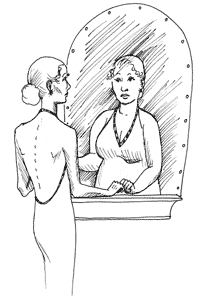|

DRAWING BY DEBORAH DERR McCLINTOCK
Q. For people with various disorders, what are the perils and possibilities of looking into a looking glass? –A.I. Wonderland
A. Given our culture's obsession with appearance and image, anorexics can look into a mirror and see too much body fat, or male bodybuilders may think they look weak, says Mark Pendergrast in Mirror Mirror: A History of the Human Love Affair with Reflection. When a Chicago psychologist designed an adjustable mirror that at first made people look tall and elongated with tiny feet, then short with a big head and tapering legs, many of them had difficulty correcting the mirror image to reflect a true image of themselves.
A third-year medical student with "body dysmorphic disorder" couldn't stop trying for hours to fix her hair in the glass. "When I look into the mirror, the obsession switches on," she said.
Schizophrenics often react oddly to mirrors, as do autistic children or old folks with Alzheimer's. Some of these have conversations with their reflection, or shy away altogether. Prosopagnosiac Bill Choisser writes in his book Face Blind that he will conclude "it must be me in the mirror because I am the only one in the bathroom."
Neurologist Vilayanur Ramachandran uses mirrors in a "virtual reality box" so amputees can "see" themselves as having their limb again, says Pendergrast. "I can actually feel I'm moving my arm, Doctor," a relieved patient reported.
Q. Let's dust off our algebra and prove that 1 = 2, so that at the store you can pay $1 for a $2 item. Here goes. 1. assume x = y; 2. then xx (x squared) = xy (multiply both sides by x); 3. then xx - yy = xy - yy (subtract yy from both sides); 4. then (x + y) (x - y) = y(x - y) (factor both sides); 5. then x + y = y (divide both sides by x - y); 6. then x + x = x (substitute x for y because x = y); 7. then 2x = x (simplify left side); 8. then 2 = 1!!! (divide both sides by x). –A. Einstein
A. "Bogus, buster," the store clerk might declare. "Don't you know that when you go from Step 4 to Step 5 by dividing by x - y, you are actually dividing by 0, since x = y and therefore x - y = 0. Dividing by 0 is verboten in any legitimate algebra class. You ought to be ashamed of yourself. Now fork over that other buck and get your innumerate self back to school."
Q. When a romance of yours ends, what is likely to be in store for you as a) breaker? b) breakee? c) mutual? –A. Landers
A. Which of these you happen to be matters– a lot, says Elliot Aronson in Social Psychology, summarizing research by Robin Akert, who interviewed 344 college-age men and women. Not surprisingly, breakees (the ones dumped) were miserable, reporting high levels of loneliness, depression and anger, plus physical disorders such as headaches, stomach aches, poor sleep.
Not so for most of the breakers (the ones doing the dumping), who felt some guilt and unhappiness but had far fewer physical symptoms. The "mutual" role (amicably agreeing to end it) helped individuals evade some of the negatives, with neither partner being as upset or hurt, though not getting off as easily as breakers. Some 60 percent of the mutuals reported physical symptoms. It's here that both men and women are equally interested in maintaining a future friendship together.
So if you're in a romance your partner seems inclined to break off, try to end it mutually. "Unfortunately for your partner, if you're about to be in the role of breaker, you will experience less pain and suffering if you hold to that role. However, switching from breaker to mutual would be an act of kindness to your soon-to-be ex-loved one."
Q. The ancient game of Nim is an easy hustle. That is, until you run up against somebody like Nick the Greek... –H.U.H.
A. Nim's usually played by scattering matchsticks on a table, then the two opponents take turns removing 1, 2 or 3 at a time. The player removing the last match wins.
The trick is to count the matches on the sly before your first move, then try to reduce the number to a multiple of 4. For instance, if there are 41 matches in the pile, take away 1. Then if your opponent takes 2, you take 2 (leaving 36), and so on. When the pile shrinks to just 4, your opponent must take 1, 2 or 3, allowing you to remove 3, 2 or 1– and win.
But beware of Nick's trick, as recounted in Harry Anderson's Games You Can't Lose. Seems Dandalos would play along, letting his opponent think he had the game with a sure count, then the Greek would remove one match while secretly adding another one he had palmed, putting the count back where it was. Usually, his mark wouldn't notice until the last move, then figure he had miscounted early on.
Moral: "A man who is sure he is about to rip off another is not particularly observant."
Send Strange questions to brothers Bill and Rich at .
#
|